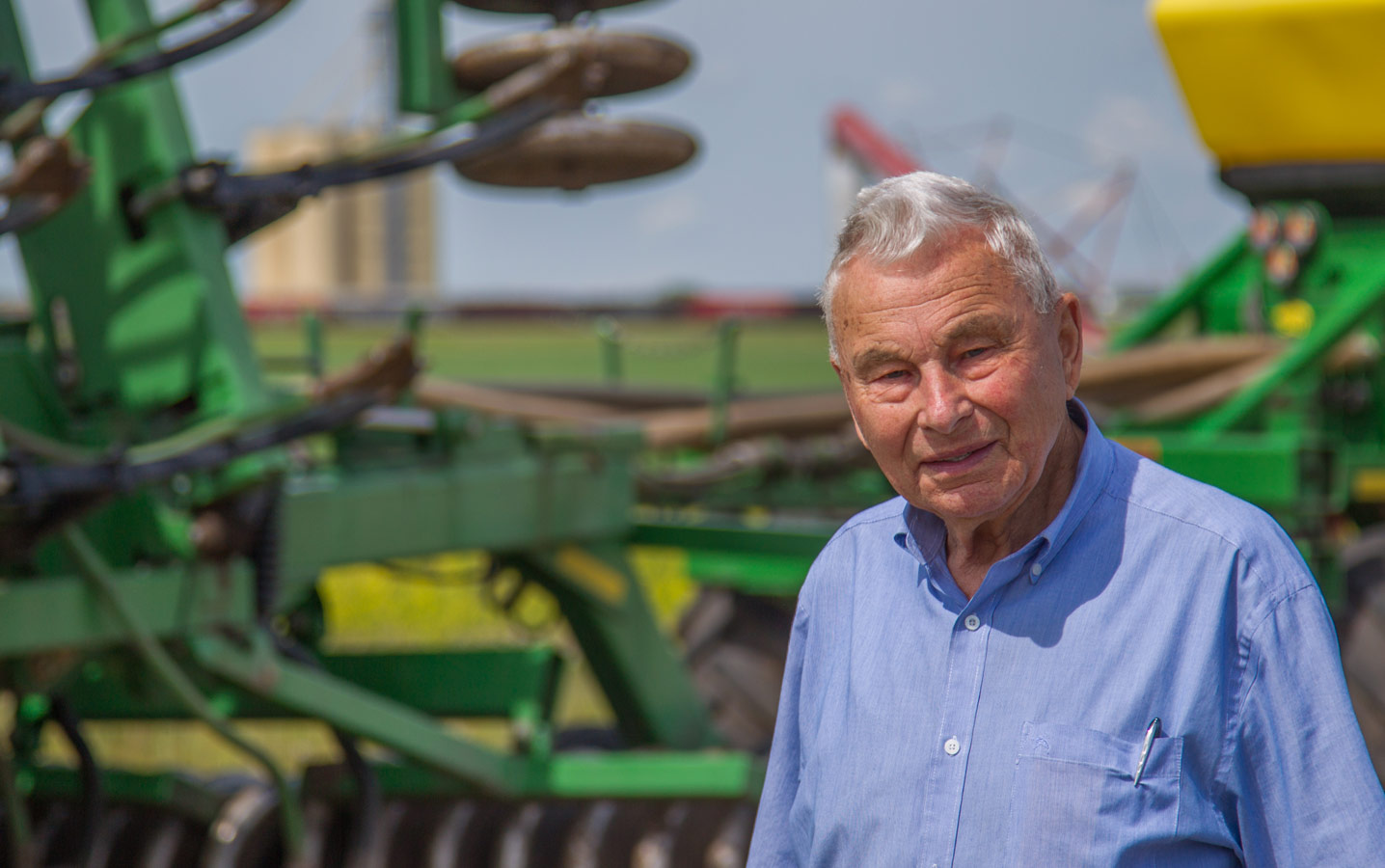50 Years of Growing Brassicas
 Keith Marshall
Keith Marshall
Ninga, Manitoba
Keith Marshall’s father, Douglas S. Marshall, was on the first board of the Rapeseed Association of Canada. That was 1967. Douglas was born in England and lost his parents at a young age. Keith says his dad might have come to Canada as a Barnardo Boy. The Barnardo charity in the U.K. sent thousands of orphaned boys to Canada as labourers from the 1860s to 1930s. Douglas trained to be a mechanic and ran a garage in Lenore, Manitoba. During World War II, his father-in-law invited him down to Ninga to manage the farm while his brother-in-law was overseas. When the brother-in-law came back, the two worked together for a year or so until Douglas bought the neighbouring farm in 1946. Keith says his mother lived on the same section of land for 90 of her 97 years.
Keith doesn’t recall how his dad came to be on the Rapeseed Association’s first board. “I was the boy who stayed home to work,” he says. Besides crops, the farm had milk cows and registered hogs. Keith credits his mother for keeping things going while his dad was involved in various organizations, including Manitoba Pork, Manitoba Farm Bureau and the school board.
The Marshalls grew rapeseed for the first time in 1963. Keith was around
20 at the time. “We were open to trying something new and there was no
hesitation in terms of finding a market for it,” he says. Demand was there.
“I remember hauling that first harvest to the UGG elevator. The elderly man who ran Northstar Oil was there and was quite excited to see it.”
The fear with Argentine rapeseed at that time, Keith says, was that if it got too ripe in the fall it would shatter like mad. Because the plants were knitted together, the story was that as soon as the swather started at one end, it would send waves of shattering across the whole field. Based on that concern, the Marshalls swathed in the rain if they could. They used an Oliver ground-driven swather at that time — so if they slowed down, the cutter bar and reel also slowed down. It was better to swath in the rain so they could swath faster.
Yields were 15 to 20 bu./ac., Keith says.
To seed the crop, which they did with box drills and then press drills in the early years, they added fertilizer to the seed to bulk it up so it would flow consistently.
The primary problem weed in that part of Manitoba at the time was wild millet. They used herbicides TCA and Dowpon to target the weed. Later on, sow thistle became a problem and they spot-sprayed with Lontrel.
Over the years, the Marshalls put a quarter to a third of their acres into rapeseed and then canola.
Keith retired from farming about 10 years ago, but he and his wife, Maureen, stayed in the tiny community of Ninga where lots are cheap and he has space for a shop and his collection of vintage tractors — including a 1928 Allis Chalmers that has been in the family its whole life.
 Garry Thiel
Garry Thiel
Shellbrook, Saskatchewan
Garry Thiel’s farmyard is three miles north of the original farm of Fred and Olga Solovonuk, the first known producers of rapeseed in Western Canada. The Solovonuks brought rapeseed from their native Poland and in the 1930s they grew the first field crop of rapeseed in Western Canada.
In Thiel’s experience, straight-combined canola yields more and has heavier bushel weight.
Thiel’s father started growing rapeseed in 1948 or ’49.
Thiel remembers watching the combine, a Model 21 Massey with a straight-cut header. The combine had a platform where two men worked on the fly to bag and stitch harvested rapeseed into 100-pound jute bags. Bags went to the buyer at Moose Jaw.
Within two or three years, harvest practices shifted dramatically as local buyers came along who would take bulk — no more bagging — and straight combining gave way to swathing.
Weeds motivated the switch to swathing, Thiel says. Because chemical weed control was not an option in rapeseed at that time, big green weeds growing among the ripe crop made straight cutting difficult. Growers would often wait for a frost to soften the weeds before combining. By switching to swathing, they could cut earlier and cure weeds in the windrow.
Weed challenges also influenced the seeding operation. The Thiels used a three-step tool back then – a plow for weed control, a packer to smooth the seedbed and a press drill to seed rapeseed at about half an inch deep. When Treflan came along “it was a godsend for rapeseed
growers,” Thiel says.
Through those early years, Polish rapeseed remained the more popular option in the area. Argentine rapeseed was available, but Thiel says it was much later maturing and didn’t suit the shorter season around Shellbrook.
Thiel’s son Grant now runs the farm, which put in about 3,000 acres of canola this year. They target a variety of markets, growing high erucic acid rapeseed (HEAR) for Bunge’s industrial market, Nexera speciality oil canola for the human food market, 1,500 acres or so of classic canola and about 1,000 acres of non-GE Clearfield canola for a processor in Saskatoon. Thiel is a shareholder in the start-up business.
The Thiels are also trying soybeans – mostly because they need more rotation crops.
“Canola has been a very lucrative crop for our area,” Thiel says. But for that reason, canola rotations are so tight that he feels the risk for diseases like clubroot and blackleg is getting too high. “We need an economical rotation crop that can help break that cycle, and soybeans might be it.”
Another change on the Thiel farm is the return of straight cutting for canola. A few years ago, Thiel was in Europe and noticed that growers there straight combined the crop. So he started to experiment. Two years ago, they swathed only 30 per cent of their canola. This year, the Thiels ordered two new Vario straight-cut headers for their Claas combines to reduce their swathed acres even more. Vario headers have the knife that extends beyond the reel, keeping any seed that shatters on contact to stay on the platform and move into the combine. In his experience, straight combined canola yields more and has heavier bushel weight. And with new pod-shatter resistance available through a few seed sources, he doesn’t worry much about wind.
To seal the deal, last fall his standing canola was flattened by snow in October. But he combined it dry soon after the snow melted. By using lifters on the header and cutting perpendicular to the lay of the crop, it combined smoothly. As for the swathed canola, he says it took a lot longer for snow to melt from the windrows and a lot of it was harvested tough.
 Walter Paszkowski
Walter Paszkowski
Sexsmith, Alberta
Walter Paszkowski’s parents emigrated to Canada from Poland and they knew rapeseed well. It was a popular crop in Poland for vegetable oil and animal feed. When Paszkowski started growing rapeseed on the family’s Sexsmith farm, his father was afraid it would become a significant new weed in the area. But by then farmers had herbicides that could control the “weed” in cereal crops.
Rapeseed was well suited to the growing conditions in the Peace region, but growers soon discovered that varieties were not strong against a disease called brown girdling root rot. Part of the problem was rotation, Paszkowski says. The rotation on their farm and many others in the area included fescue, and fescue was also a host crop for the pathogen.
The challenge of properly placing seed at a consistent shallow depth in loose tilled soil made the disease situation worse, he says. Tiny Polish seeds placed a couple of inches deep were less vigorous and more subject to disease. The shift to no-till kept the seedbed firm and solved the seed depth issue “quite nicely,” he says. The combination of rapeseed and no-till was an economic win for farmers in the Peace region and it caught on quickly.
The Peace River Rapeseed Growers Association formed in the 1960s. Three years later, the association expanded to include all of Alberta and was renamed the Alberta Rapeseed Growers Association. (That association later became the first levy-funded commission in Alberta, changing its name to Alberta Canola Producers Commission.)
Paszkowski got involved with Alberta Rapeseed Growers in the early 1970s and stayed involved through the transition from rapeseed to canola. The transition was forced, he recalls, by global market competition. Major competitors were using a rat study to bad-mouth the erucic acid in rapeseed oil, he says, and because rapeseed was really the only vegetable oil that had any potential in Canada at the time, the country needed to act fast to stay in the market. “Rapeseed was further advanced in Canada than sunflowers or soybeans and it could be grown across all farming regions,” he says. “I have to give the researchers a tremendous medal of honour for what they did to create canola in such a short period of time.”
As ARGA president at the time, Paszkowski was the association’s rep on the Rapeseed Association of Canada board when it voted to change its name to the Canola Council of Canada.
“The Canola Council of Canada, which brought together all the players including crushers, exporters, provincial grower organizations, government, universities and food and feed manufacturers, became and still is the best and most complete commodity organization in Canadian agriculture,” Paszkowski says. “That has been a major reason for the canola industry’s growth to become the major crop in Canada. And it’s still growing.”
Paszkowski left ACPC in 1989 when he was elected MLA in the Alberta legislature. He still lives in Sexsmith and his son, Dwayne, runs the farm.
Murray McConnell
Petersfield, Manitoba
Murray McConnell’s father started the family seed business in 1938.
“My father received seed barley in 1938 through his sister Edna McConnell, who was attending the University of Saskatoon to obtain her ag degree,” he says. (Edna eventually became the first female agricultural representative in Canada.) That barley propelled the family into the seed business, which Murray McConnell carried on into the early 2000s.
Somewhere in the middle of all those years, the McConnells were one of the first families to grow a breeder’s seed plot of canola.
They were near-neighbours to Baldur Stefansson, one of the fathers of canola, who lived 14 miles down the road at Gimli. Stefansson knew them from the seed business. “We received canola breeder seed from Stefansson to grow in a seed plot,” says McConnell. “I still have the letter he had sent with the seed and for that reason, I believe that we were one of the earliest seed producers to grow it.”
He doesn’t remember canola being that big a deal at first. “It had a different name, but as a grower, it was similar to regular rapeseed.”
Though not in the seed business anymore, McConnell, at 84, still farms in the Petersfield area.
Explore CanolaHistory.ca for videos, an interactive timeline and the opportunity
to share your canola story.





